We’ve seen how airports are using social media in order to further convenience their customers, but do the industry leaders, the other CEO’s, and directors of these Airports think that social media is benefitting their business? With only 7.4% of airports contributing a considerable amount of man-hours per month for social media, one would think that it is not valued in today’s air industry. That is merely a statement coming from an outside observer.
David McMullen, writer for Simpliflying interviewed Paul O’Kane the Director of Public Affairs for Dublin Airport Authority about how he created Dublin Airport’s online presence on social media. Starting with, their Official Twitter account, which took four months to get the handle, (username) @DublinAirport, because someone who was unaffiliated with the airport was using it. After setting up the account, Paul began to realize it’s true potential. One way that they are utilizing social media is with crisis management.
Go back to winter of 2010; Dublin Airport was hit with several feet of snow causing runway delays and closings. While other airports were having the closing listed on flight boards and being read over the speakers, making the fliers have to stand in front of them anxiously waiting to see the status of their flight, Dublin was tweeting about it. In July of 2013, a small jet landing at Dublin suffered a blown front tire upon landing in which the main runway had to be closed. Paul decided the best way to alert fliers and the media would be to tweet about it. Because of the immediate information output via twitter, they were able to say that the incident had happened and that the airport was still operational with no injuries. Because they got the information out so quickly, the press reported the story from the tweets. This cut down on exposure, and the media making this a bigger deal than it was. In the video below, the full interview with Paul O’Kane from Simpliflying, Paul tells the story of how they used twitter to get UEFA Euro 2012 Championship tickets back to a flier who left them at the airport.
Paul O’Kane and the rest of the Public Affairs Department at Dublin Airport are doing an excellent job at using social media in a smart, effective way. Twitter was only the beginning for Dublin; since then they have made an official Facebook page that has 43,000 likes, and a four star rating from the 840 people who have reviewed it. One of the reasons that Dublin has been met with such success is the way in which they are posting updates on different social media platforms. Paul believes that it is necessary to find the right tone in which to deliver the information. In the interview posted with Paul, he talks about how one of the tweets about the blown tire was revised from “a plane suffered a burst tire” to “there was a tire deflation on the runway.” Paul also says that it is necessary to understand what you are trying to accomplish through social media, and that support from someone higher up in the company. In terms of whether or not Paul thinks that social media is important in the aviation industry, Paul has this to say; “There are two types of aviation people in the world -those who’ve got social media, and those who are about to get it.” It will be interesting to see if the number of airports using social media to reach their customers will increase in the years to come.

